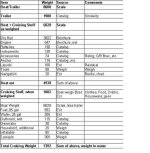The Tomcat manual (http://www.c-dory.com/owners/manuals/to ... manual.pdf) lists the following:
Hull Weight less motors, batteries, controls: 6,000 pounds
Design Weight (boat, motor, fuel, gear, passengers): 7500 pounds
Maximum Gross Weight: 8,000 pounds
Motors including batteries and controls (2 Honda 150): 1,100 pounds
Full Fuel (150 gal x 6 pounds): 900 pounds
Full Water (30 gal x 8.35 pounds): 250 pounds
So before I even add passengers, or even a paper chart, at full fuel and water, with motors, batteries, and controls, I am at 8,250 pounds - 250 pounds over maximum gross and 750 pounds over design weight.
What am I doing wrong or missing here?
Peter
Hull Weight less motors, batteries, controls: 6,000 pounds
Design Weight (boat, motor, fuel, gear, passengers): 7500 pounds
Maximum Gross Weight: 8,000 pounds
Motors including batteries and controls (2 Honda 150): 1,100 pounds
Full Fuel (150 gal x 6 pounds): 900 pounds
Full Water (30 gal x 8.35 pounds): 250 pounds
So before I even add passengers, or even a paper chart, at full fuel and water, with motors, batteries, and controls, I am at 8,250 pounds - 250 pounds over maximum gross and 750 pounds over design weight.
What am I doing wrong or missing here?
Peter

